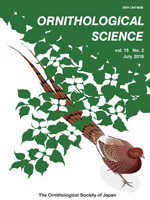The Korean peninsula is geographically important for the migration of geese. Several thousand geese visit South Korea every winter, but currently it is unclear which habitats are preferred by the geese. Understanding patterns of habitat usage is important for establishing conservation strategies, as some habitats may be disappearing more rapidly than others making it critical to know whether or not a disappearing habitat is crucial to certain birds. In this study, we investigated the habitat use of the wintering populations of Bean Goose Anser fabalis and Greater White-fronted Goose A. albifrons. We found that the wintering populations of these two geese species in South Korea have stabilized after sudden increases during the mid and late 2000s. Both species formed larger wintering populations at coastal lakes, on reclaimed lands, and at estuaries than on freshwater habitats, which may be related to the availability and/or diversity of food items. Considering that environmental changes resulting from development and climate change are reducing the inshore areas and estuaries, the role of artificial wetlands, such as reclaimed areas that are used as rice fields, is important for conservation of geese that overwinter in Korea.
BioOne.org will be down briefly for maintenance on 17 December 2024 between 18:00-22:00 Pacific Time US. We apologize for any inconvenience.
How to translate text using browser tools
1 July 2016
Habitat Use and its Implications for the Conservation of the Overwintering Populations of Bean Goose Anser fabalis and Greater White-Fronted Goose A. albifrons in South Korea
Min Kyung Kim,
Sang-im Lee,
Sang Don Lee
ACCESS THE FULL ARTICLE

Ornithological Science
Vol. 15 • No. 2
July 2016
Vol. 15 • No. 2
July 2016
Bean Goose
conservation strategy
white-fronted goose
wintering habitat




